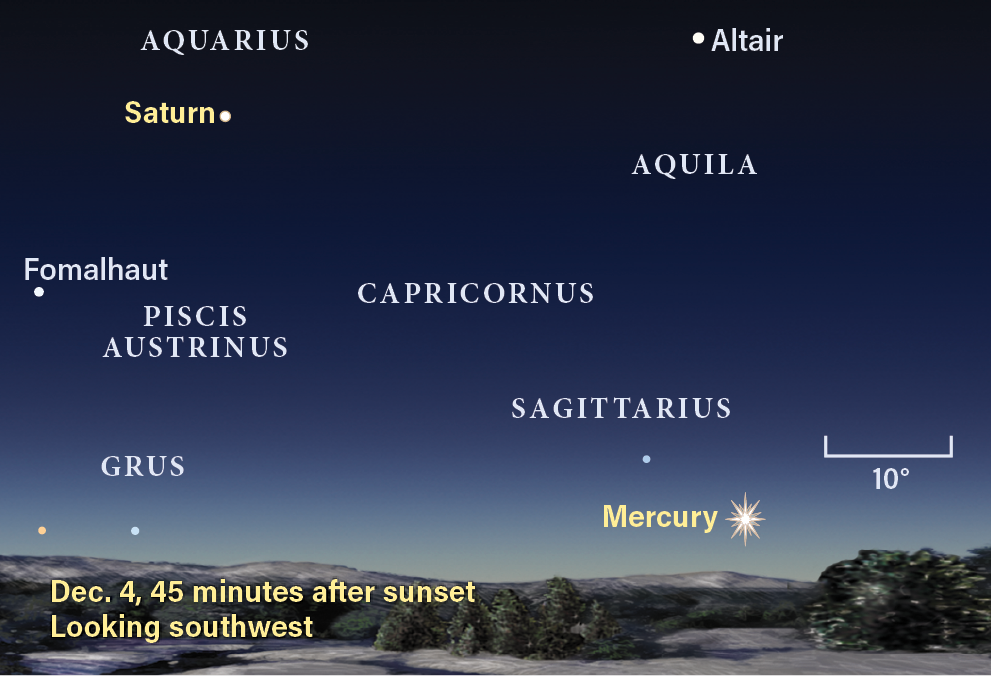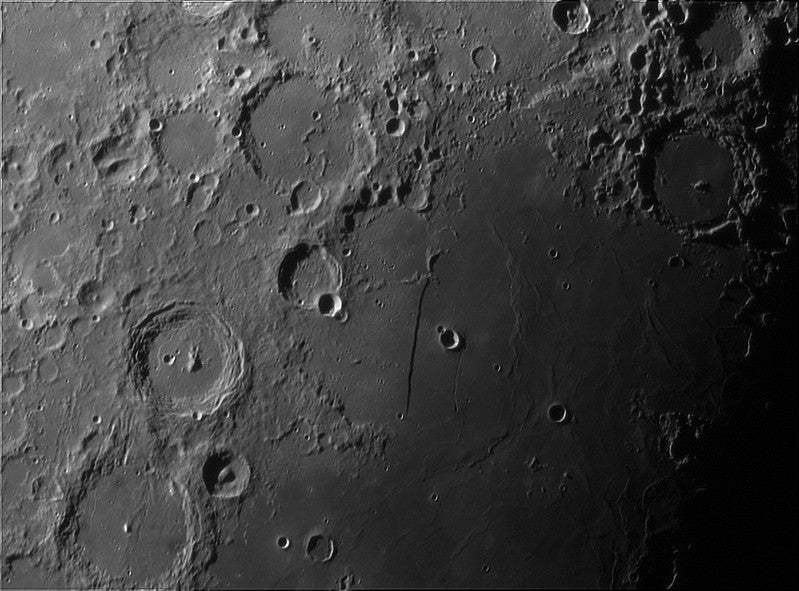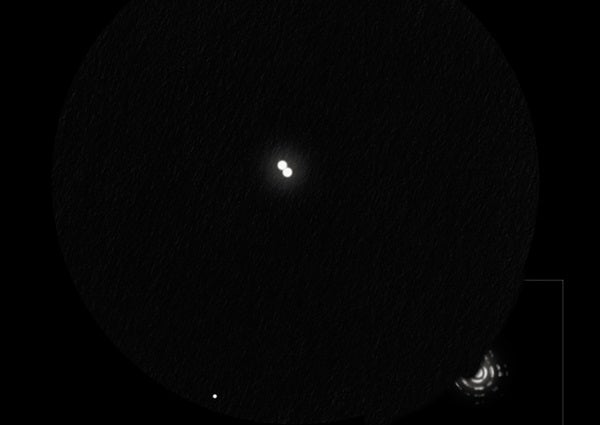
Friday, December 1
Many people have heard of the Summer Triangle — the large, three-pointed asterism that flies high overhead on warm summer nights and is now sinking toward the western horizon after dark. But have you heard of the Winter Triangle? This cold-weather asterism is now rising in the east late in the evening, inching higher into the sky day by day as we prepare for winter to begin.
The Winter Triangle is anchored by three famous stars: Betelgeuse in Orion, which is the first to rise, followed by Procyon in Canis Minor, and finally Sirius in Canis Major. This last star is anything but least: Magnitude –1.4 Sirius is the brightest star in the sky. To its upper left above the horizon, Procyon is no slouch at magnitude 0.4. And red-hued Betelgeuse, to Procyon’s upper right and the upper left of Orion’s recognizable three-star belt, is nearly as bright at magnitude 0.5.
The entire Winter Triangle is above the horizon by 10 P.M. local time and will keep rising as the night progresses. In the center of the Triangle is a large portion of the lesser-known constellation Monoceros the Unicorn, whose most famous constituent is likely the stunning Rosette Nebula near its western border where it meets Orion. Any small scope should show the stars of NGC 2244, the open cluster at the center of this nebula. If you have a nebula filter, be sure to slip it in to see if you can spot the Rosette’s gauzy glow around the bright group of stars. A wide field of view will also help ensure you capture the extended nebula.
Sunrise: 7:03 A.M.
Sunset: 4:35 P.M.
Moonrise: 8:27 P.M.
Moonset: 11:06 A.M.
Moon Phase: Waning gibbous (81%)
*Times for sunrise, sunset, moonrise, and moonset are given in local time from 40° N 90° W. The Moon’s illumination is given at 12 P.M. local time from the same location.
Saturday, December 2
Let’s spy on mighty Saturn tonight, located due south at sunset. As the sky starts to grow dark, pull out your telescope and turn it toward the ringed planet, some 40° above the horizon and glowing at magnitude 0.8. As the night progresses, the planet will trend westward and start to set, so the earlier you can observe it the better.
The disk of Saturn now stretches about 17″ across, with its rings spanning 38″ — both will appear to shrink just slightly over the course of the month. Nonetheless, the rings are one of the most breathtaking sights you’ll ever see; they have inspired many a future astronomer. Right now, the rings are tilted toward Earth at an angle of 10°, offering a good view of most of the planet’s disk.
Saturn’s largest and brightest moon is Titan, which now lies just over 2′ east of the planet’s center and glows around 8th magnitude. You should be able to pick it up in most instruments, especially against a darker sky. The fainter, 10th-magnitude moon Tethys lies due west of Saturn and much closer, about 20″ from the tip of the rings. Rhea and Dione, also both 10th magnitude, are just south and north of the planet, respectively. Note, however, that after about 7:15 P.M. EST, you won’t see Dione — it’s moved into Saturn’s shadow, which stretches off to the northeast. It will reappear even farther northeast around 8:40 P.M. EST.
Sunrise: 7:04 A.M.
Sunset: 4:35 P.M.
Moonrise: 9:31 P.M.
Moonset: 11:39 A.M.
Moon Phase: Waning gibbous (73%)
Sunday, December 3
Observers who catch Jupiter fairly early in the evening tonight can see all four of its Galilean moons strung out to the west. As time passes, though, one of those moons will disappear as Europa slips behind the planet, reappearing on the other side shortly after the next in line, Io, begins its own journey behind Jupiter’s face.
Let’s start by locating Jupiter, already visible at sunset. Look about 20° above the eastern horizon shortly after the Sun disappears to find the bright, magnitude –2.8 planet. It will continue to rise higher as darkness falls. It’s the brightest object in the evening sky right now and is hard to miss!
With large binoculars or a telescope, zoom in on Jupiter and you’ll see four staggered points of light to its west. Closest is Europa, next out is Io, then Ganymede, and Callisto farthest out. Keep watching over the next few hours: You’ll notice Europa clearly approaching the planet’s limb. Also rotating into view on Jupiter’s face during this time is the Great Red Spot, a giant, Earth-sized storm just south of the planet’s equator. It crosses the middle of the disk shortly before midnight EST.
Not long before that, Europa finally disappears around 11:32 P.M. EST. Although it technically clears the planet’s eastern limb shortly before 1 A.M. on the 4th in the Central time zone (2 A.M. EST; still the 3rd in time zones farther west), the moon must still travel through Jupiter’s extended dark shadow. It takes until 3:25 A.M. EST for Europa to reappear, some 25″ from Jupiter’s eastern limb.
Meanwhile, Io is quickly approaching the planet. It disappears shortly after 3:10 A.M. EST on the 4th and doesn’t reappear until Jupiter has already set or is very low to the western horizon.
Sunrise: 7:05 A.M.
Sunset: 4:35 P.M.
Moonrise: 10:33 P.M.
Moonset: 12:06 P.M.
Moon Phase: Waning gibbous (64%)

Monday, December 4
Mercury reaches greatest elongation from the Sun (21° east) at 9 A.M. EST. The planet is visible as an “evening star” for a short time after the Sun sets, so you’ll want to get outside as twilight begins to fall for the best chance to catch it.
Look southwest and you’ll spot Mercury some 7° above the horizon half an hour after sunset. It’s currently in the constellation Sagittarius, hanging some 40° directly below the bright star Altair in Aquila. Although the stars making up the Archer’s Teapot asterism won’t be visible in the fading light, Altair’s magnitude 0.8 light should pierce the twilight soon after sunset.
Mercury is brighter at magnitude –0.4; through a telescope, the tiny planet spans 7″ and shows off a 62-percent-lit face. After today, it will first begin to fade in brightness and wane in phase, then start to “fall” back toward the Sun starting early next week. It will disappear before Christmas, reaching inferior conjunction on the 22nd.
The Moon reaches apogee, the farthest point from Earth in its orbit around our planet, at 1:42 P.M. EST. At that time, Luna will sit 251,249 miles (404,346 kilometers) away.
Sunrise: 7:05 A.M.
Sunset: 4:35 P.M.
Moonrise: 11:34 P.M.
Moonset: 12:29 P.M.
Moon Phase: Waning gibbous (55%)

Tuesday, December 5
Last Quarter Moon occurs at 12:49 A.M. EST. Our satellite now rises late (shortly after midnight) and rules the early-morning hours, showing off the western half of its Earth-facing nearside. Early risers can enjoy this lesser-observed phase, which shows off the rugged, cratered terrain in the lunar south quite fantastically, as well as the huge, dark Oceanus Procellarum (Ocean of Storms) near the western limb. The prominent crater Copernicus, surrounded by an apron of bright debris, is also visible in the northwest.
For those seeking a telescopic challenge, try the Straight Wall, or Rupes Recta, in the Sea of Clouds. This lunar fault line is nearly 70 miles (113 km) long and 1.5 miles (2.4 km) wide; you can use the nearby crater Arzachel to find it, as it lies just southwest of this impact site. During Last Quarter, the Straight Wall may appear as a bright line — this actually makes it harder to spot than the dark shadow it leaves during First Quarter, so if you have trouble now, just wait until a few days after the next New Moon and try again, this time in the early evening.
Sunrise: 7:06 A.M.
Sunset: 4:34 P.M.
Moonrise: —
Moonset: 12:50 P.M.
Moon Phase: Waning crescent (45%)
Wednesday, December 6
Neptune stands stationary against the background stars of Aquarius at 7 P.M. EST tonight. In fact, you’ll find it right at the border of that constellation and Pisces, where the planet sits some 7.5° southeast of the Circlet asterism in the Fish. The easiest way to spot the ice giant is to first find magnitude 4.5 Lambda (λ) Piscium, the southeasternmost star in the Circlet, and drop 5° due south to land right on Neptune.
The distant world appears just 2″ wide, though in reality it’s nearly four times the width of our planet. It’s now magnitude 7.7; it will soon drop just 0.1 magnitude to 7.8 for the rest of the year. This is too faint to see with the naked eye, but binoculars or any small telescope will pick it up. Look for a “flat,” round star with a bluish or grayish cast.
Neptune was previously moving retrograde, or westward against the background stars. It will now begin moving prograde, or eastward, but so slowly that it will essentially appear to sit in the same spot all month — you can take a photo or plot out several nearby stars in a logbook and come back to check its meager progress over the next few weeks.
Sunrise: 7:07 A.M.
Sunset: 4:34 P.M.
Moonrise: 12:33 A.M.
Moonset: 1:10 P.M.
Moon Phase: Waning crescent (36%)

Thursday, December 7
The Moon floats close to a famous bright double star early this morning in Virgo. Look east around 3:30 A.M. and you’ll spot Luna some 20° above the horizon, now a delicate waning crescent. Just left of the moon is a bright star — that’s Gamma (γ) Virginis, also known as Porrima.
Shining at magnitude 2.7, Porrima at first glance appears like nothing special. But through a telescope, you’ll see it split into two stars that look nearly identical. One is magnitude 3.65, while the other is magnitude 3.56. (No, that’s not a typo!)
In addition to their twinlike appearance, these stars have some important historical significance under their belt. They provided evidence for Newton’s theory of gravity, as astronomers were able to record their motions and ultimately chart their orbits. The two circle each other completely once every 169 years or so, appearing up to 6″ apart at their widest. But at their closest, they are difficult to split even for larger telescopes — so, when astronomers saw these stars “merge” into one at the predicted time based on the orbits they’d charted, the event showed that gravity worked as expected, even in a distant star system.
Sunrise: 7:08 A.M.
Sunset: 4:34 P.M.
Moonrise: 1:33 A.M.
Moonset: 1:30 P.M.
Moon Phase: Waning crescent (27%)
Friday, December 8
As Leo rises above the eastern horizon early this morning, let’s look for Comet 62P/Tsuchinshan 1, currently making its way from nose to tail through the Lion.
Today it’s pretty easy to find, about 5.5° due north of blazing Regulus, Leo’s magnitude 1.4 alpha star. For a closer signpost, look for magnitude 3.5 Eta (η) Leonis; Tsuchinshan 1 is just 50′ northeast of this star in the early-morning hours before sunrise. The comet has been recently observed around magnitude 9.6 and should be visible as a faint fuzzball through larger binoculars or most telescopes. Tsuchinshan 1 never brightens past about magnitude 7, so astronomers think it’s quite small — less than a mile (1.6 km) in diameter.
Regulus and Eta Leonis are themselves part of an asterism within Leo known as the Sickle, which looks like a backwards question mark. Starting at Regulus, draw an imaginary line up to Eta, then northeast to Gamma (γ) Leo, and clockwise from there to Zeta (ζ), Mu (μ), and Epsilon (ϵ) Leo.
We’ll keep following the comet throughout the month, especially as it approaches several galaxies in the Lion’s haunches.
Sunrise: 7:09 A.M.
Sunset: 4:34 P.M.
Moonrise: 2:34 A.M.
Moonset: 1:51 P.M.
Moon Phase: Waning crescent (19%)

Sky This Week is brought to you in part by Celestron.









